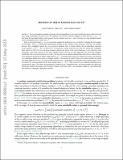| dc.contributor.author | Bartha, Zsolt | |
| dc.contributor.author | Sun, Nike | |
| dc.contributor.author | Zhang, Yumeng | |
| dc.date.accessioned | 2021-11-01T18:11:14Z | |
| dc.date.available | 2021-11-01T18:11:14Z | |
| dc.date.issued | 2019 | |
| dc.identifier.uri | https://hdl.handle.net/1721.1/137022 | |
| dc.description.abstract | © 2019 IEEE. For several models of random constraint satisfaction problems, it was conjectured by physicists and later proved that a sharp satisfiability transition occurs. In the unsatisfiable regime, it is natural to consider the problem of max-satisfiability: violating the least number of constraints. This is a combinatorial optimization problem on the random energy landscape defined by the problem instance. In the bounded density regime, a very precise estimate of the max-sat value was obtained by Achlioptas, Naor, and Peres (2007), but it is not sharp enough to indicate the nature of the energy landscape. Later work (Sen, 2016; Panchenko, 2016) shows that for very large but bounded density, the max-sat value approaches the mean-field (complete graph) limit: This is conjectured to have an 'FRSB' structure where near-optimal configurations form clusters within clusters, in an ultrametric hierarchy of infinite depth inside the discrete cube. A stronger form of FRSB was shown in several recent works to have algorithmic implications (again, in complete graphs). Consequently we find it of interest to understand how the model transitions from 1RSB near the satisfiability threshold, to (conjecturally) FRSB at large density. In this paper we show that in the random regular NAE-SAT model, the 1RSB description breaks down by a certain threshold density that we estimate rather precisely. This is proved by an explicit perturbation in the 2RSB parameter space. The choice of perturbation is inspired by the 'bug proliferation' mechanism proposed by physicists (Montanari and Ricci-Tersenghi, 2003; Krzakala, Pagnani, and Weigt, 2004), corresponding roughly to a percolation-like threshold for a subgraph of dependent variables. | en_US |
| dc.language.iso | en | |
| dc.publisher | Institute of Electrical and Electronics Engineers (IEEE) | en_US |
| dc.relation.isversionof | 10.1109/FOCS.2019.00086 | en_US |
| dc.rights | Creative Commons Attribution-Noncommercial-Share Alike | en_US |
| dc.rights.uri | http://creativecommons.org/licenses/by-nc-sa/4.0/ | en_US |
| dc.source | arXiv | en_US |
| dc.title | Breaking of 1RSB in Random Regular MAX-NAE-SAT | en_US |
| dc.type | Article | en_US |
| dc.identifier.citation | Bartha, Zsolt, Sun, Nike and Zhang, Yumeng. 2019. "Breaking of 1RSB in Random Regular MAX-NAE-SAT." Proceedings - Annual IEEE Symposium on Foundations of Computer Science, FOCS, 2019-November. | |
| dc.contributor.department | Massachusetts Institute of Technology. Department of Mathematics | |
| dc.relation.journal | Proceedings - Annual IEEE Symposium on Foundations of Computer Science, FOCS | en_US |
| dc.eprint.version | Original manuscript | en_US |
| dc.type.uri | http://purl.org/eprint/type/ConferencePaper | en_US |
| eprint.status | http://purl.org/eprint/status/NonPeerReviewed | en_US |
| dc.date.updated | 2021-05-26T16:38:13Z | |
| dspace.orderedauthors | Bartha, Z; Sun, N; Zhang, Y | en_US |
| dspace.date.submission | 2021-05-26T16:38:14Z | |
| mit.journal.volume | 2019-November | en_US |
| mit.license | OPEN_ACCESS_POLICY | |
| mit.metadata.status | Authority Work and Publication Information Needed | en_US |
